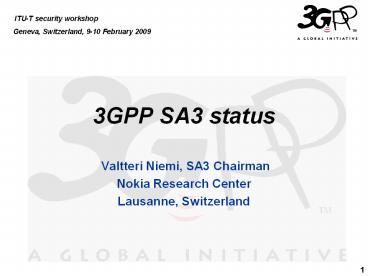3GPP SA3 status - PowerPoint PPT Presentation
Title:
3GPP SA3 status
Description:
... (out of these 19) originated by ETSI SAGE, e.g. TS 35.202 'KASUMI specification' For Release 4 (frozen 2001), SA3 was kept busy with GERAN security while ETSI ... – PowerPoint PPT presentation
Number of Views:83
Avg rating:3.0/5.0
Title: 3GPP SA3 status
1
3GPP SA3 status
ITU-T security workshop Geneva, Switzerland,
9-10 February 2009
- Valtteri Niemi, SA3 Chairman
- Nokia Research Center
- Lausanne, Switzerland
2
Outline
- Some history and background
- SAE/LTE security some highlights
- Home (e)NodeB security
- Other work items
3
Some history and background
4
Some history (1/2)
- For 3GPP Release 99 (frozen 2000), WG SA3 created
19 new specifications, e.g. - TS 33.102 3G security Security architecture
- 5 specifications (out of these 19) originated by
ETSI SAGE, e.g. TS 35.202 KASUMI specification - For Release 4 (frozen 2001), SA3 was kept busy
with GERAN security while ETSI SAGE originated
again 5 new specifications, e.g. - TS 35.205-208 for MILENAGE algorithm set
- Release 5 (frozen 2002) SA3 added 3 new
specifications, e.g. - TS 33.203 IMS security
- TS 33.210 Network domain security IP layer
5
Some history (2/2)
- Release 6 (frozen 2005) SA3 added 17 new
specifications, e.g. - TS 33.246 Security of MBMS
- TS 33.220-222 Generic Authentication
Architecture - Release 7 (frozen 2007) SA3 added 13 new
specifications - ETSI SAGE created 5 specifications for UEA2
UIA2 (incl. SNOW 3G spec) (TS 35.215-218, TR
35.919) - Release 8 (frozen 2008) SA3 has added 5 new
specifications, e.g. - TS 33.401 SAE Security architecture
- TS 33.402 SAE Security with non-3GPP accesses
- (1-2 more TRs maybe still be included in Rel-8)
6
SAE/LTE security (Rel-8) some highlights
7
SAE/LTE What and why?
- SAE System Architecture Evolution
- LTE Long Term Evolution (of radio networks)
- LTE offers higher data rates, up to 100 Mb/sec
- SAE offers optimized (flat) IP-based architecture
- Technical terms
- E-UTRAN Evolved UTRAN (LTE radio network)
- EPC Evolved Packet Core (SAE core network)
- EPS Evolved Packet System ( RAN EPC )
8
Implications on security
- Flat architecture
- All radio access protocols terminate in one node
eNB - IP protocols also visible in eNB
- Security implications due to
- Architectural design decisions
- Interworking with legacy and non-3GPP networks
- Allowing eNB placement in untrusted locations
- New business environments with less trusted
networks involved - Trying to keep security breaches as local as
possible - As a result (when compared to UTRAN/GERAN)
- Extended Authentication and Key Agreement
- More complex key hierarchy
- More complex interworking security
- Additional security for eNB (compared to
NB/BTS/RNC)
9
Home (e) Node B security
10
Home (e)NB architecture
- Figure from draft TR 33.820
- One of the key concepts Closed Subscriber Group
11
Threats
- Compromise of HeNB credentials
- e.g. cloning of credentials
- Physical attacks on HeNB
- e.g. physical tampering
- Configuration attacks on HeNB
- e.g. fraudulent software updates
- Protocol attacks on HeNB
- e.g. man-in-the-middle attacks
- Attacks against the core network
- e.g. Denial of service
- Attacks against user data and identity privacy
- e.g. by eavesdropping
- Attacks against radio resources and management
12
Other features in past releases of 3GPP
13
IMS (SIP) security (Rel-5)
authentication key agreement
network domain security
security mechanism agreement
integrity protection
R99 access security
14
Release 6 highlights
15
WLAN interworking in 3GPP
- WLAN access zone can be connected to cellular
core network - Shared subscriber database charging
authentication (WLAN Direct IP access) - Shared services (WLAN 3GPP IP Access)
- Service continuity is the next step
16
MBMS Security Architecture (node layout)
Content Server
Mobile Operator Network
BM-SC
Content Server
BSF
Internet
BGW
BM-SC can reside in home or visited network
17
Generic Authentication Architecture (GAA)
- GAA consists of three parts (Rel-6)
- TS 33.220 Generic Bootstrapping Architecture
(GBA) offers generic authentication capability
for various applications based on shared secret.
Subscriber authentication in GBA is based on HTTP
Digest AKA RFC 3310. - TS 33.221 Support of subscriber certificates PKI
Portal issues subscriber certificates for UEs and
delivers an operator CA certificates. The issuing
procedure is secured by using shared keys from
GBA. - TS 33.222 Access to Network Application Function
using HTTPS is also based on GBA.
Figure from 3GPP TR 33.919
18
Release 7 8 highlights
19
Release 7 8 security enhancements
- Key establishment for secure UICC-terminal
channel (TS 33.110) - Applies, e.g. for secure UICC-terminal channel
specified by ETSI SCP - Built on top of GBA
- Key establishment between UICC hosting device and
a remote device (TS 33.259) - Liberty-3GPP security interworking
- GBA push (TS 33.223, Rel-8)
- Applies to several OMA specified features (e.g.
BCAST) - Network domain security Authentication Framework
(TS 33.310) enhanced for TLS support - Withdrawal of A5/2 algorithm
20
Work in progress Rel-9
21
Rel-9 work items
- SAE/LTE emergence call security
- Media security
- End-to-end and end-to-middle protection of media
independently of access technology - Protection against unsolicited communications in
IMS - Remote management of USIM/ISIM for
machine-to-machine communications - Security of Earthquake and Tsunami Warning
System
22
- For more information
- www.3gpp.org































